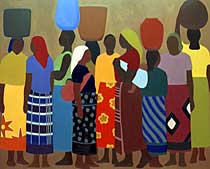It’s back-to-school time, but for those
of us who have been out of school for a few years, St. Francis
College is offering an invitation to a delightful free learning
experience at its Brooklyn Heights campus.
Accept their invite to see "Tradition/Nontradition: Bridging
the Gap," a group exhibition of paintings, etchings and
works on paper by five artists at the college’s Callahan Center,
now through Sept. 30.
The concept of "Bridging the Gap," originated by curator
and artist Dorcas Gelabert, was to reference artistic traditions
– portraiture, landscape and still life – and acknowledge that
there’s still a lot of life in those old war horses.
In her introduction to the show, author Yvette Pennacchia explains,
"The modern avant-garde impulse toward a ’break’ with the
historical past, which is the artistic legacy of the 20th century,
consists in part of a critique of some humanist ideas, which
over time degenerated into noxious and even dangerous propositions.
The once noble vision of the human being’s dignity and place
in nature deteriorated into the aggrandizement of the individual.
"In their work, all five artists try to bridge the gap between
the lessons of modernity and post-modernity and those discarded
concerns of traditional art making that endure."
All five artists – Gelabert, Diane Conlon, Edna Diolata, Roberta
Louise and Yeachin Tsai – live and work in Brooklyn and have
completed an aspect of their formal artistic training in the
borough but employ very different, yet effective, styles in their
work.
Many of Diolata’s canvases are vibrant, two-dimensional studies
of the shape of women and colors of their apparel.
In 1998, she traveled to Mozambique where she lived for two-and-a-half
years. The painter has an eye for effortlessly rendering the
regal bearing of African women carrying vessels on their heads
and gathering in conversation. Her figures are faceless parts
of a larger community, a community without men.
When she deviates from her successful formula – as in "Queendance,"
a 36-inch by 48-inch painting depicting a woman in the foreground
moving and grooving in her orange dress and turban while androgynous
figures akin to Keith Haring figures also give themselves over
to dance – her paintbrush still dazzles the eye. The composition
of undulating figures thrums with joy.
Born in Taiwan, Tsai embellishes traditional forms such as Chinese
brush painting and calligraphy by creating etchings awash in
color. She also paints minimalist landscapes on silk and paper.
Her works are careful, symbolic meditations on natural phenomena
such as meteor showers or mountains.
Gelabert’s works on paper are full of unbridled emotion, so it
makes sense that her large compositions (71 inches by 48 inches,
and larger) are too big and full of life and anguish to be contained
by frames. Simply titled "Love I, II and III" the trio
are scattered throughout the exhibit. In "Love II"
the power of human touch is powerfully represented in the awkward
but ecstatic bend of an arm triggered by such a connection.
It’s interesting to note that the starting point of Gelabert’s
work is her own body; her penciled body tracings make up the
basic structure of the images. The Cuban-born artist’s layered
compositions seem to move, seemingly revealing the history of
what came before. In "Love III," arms that let a figure
slip away, arms that no longer embrace are discernible beneath
a wash of white paint.
Roberta Louise’s still life paintings seem to meditate on the
beauty rampant in nature and that beauty’s containment, such
as her "King Proteus" flower in a vase. But "flower"
is not a powerful enough noun for this sharp-petal plant with
its massive head that seems to yearn to be free of its vase.
It’s curving, rippling leaves, reflective container and base
of wrinkled paper are all evidence of the Massachusetts native’s
mastery of technique.
Louise’s vibrant "The Opening Reception" is another
show stopper. The painting is a close examination of a lush floral
landscape, purple-red blooms bursting open against a dense thicket
of green stems. It could be inspired by Georgia O’Keeffe’s floral
studies, but Louise’s work seems more wild and tropical.
Conlon says in her artist statement that she is equally interested
in abstract and figurative art, but I found her painting, "Head,"
to be a powerful statement in favor of figurative art. The woman’s
face fills the 12-inch by 15-inch canvas, with a gaze that stubbornly
refuses to meet the viewer’s. Conlon’s accomplished portrait
of a determined woman playfully manipulates color and light.
Conlon’s "Heart II," a pulpy, mossy mass attached to
chicken wire, also attracted attention at the exhibit. The technique
may seem naïve, but it has a richness of texture and color
– a dramatic yellow, swirling brushstroke draws the viewers into
its core.
In "Tradition/Nontradition: Bridging the Gap" the curator
has accomplished her goal. The exhibit is brimming with provocative,
still relevant meditations on the mysteries of nature, women
in art, beauty and even the role of art in our community of Brooklyn
today.
"Tradition/Nontradition: Bridging
the Gap" will be on display at the Callahan Center at St.
Francis College (180 Remsen St. between Court and Clinton streets
in Brooklyn Heights) through Sept. 30. The opening reception
will be Sept. 5, from 5 pm to 7:30 pm. Gallery hours are Monday-Friday,
9 am-4 pm, and Saturday, 10 am-3 pm. The exhibit and reception
are free of charge. For more information, call (718) 489-5272.
























